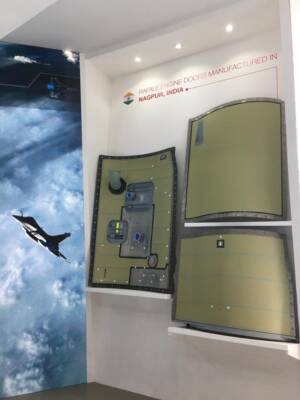
Shillong/ Bengaluru. This time, Aero India 2021 was a different picture for the entire world comprising of contemporary issues and aerospace technologies that were bound to captivate the audience. The nation’s premier aerospace and defence exhibition kick-started at Air Force Station Yelahanka in Bengaluru on February 3. The event was graced by the various dignitaries across the world with 26 countries’ physical participation and 14 other marked their virtual attendance due to new norm. With the biggest Make in India Defence contract, the mega event concluded with excitement and achievement in the past three days.
The theme of the Aero India 2021 was mainly based on the indigenisation of products, aerospace application and crucial airpower in Indo Pacific Region.
The 13th edition of Asia’s largest event was plugged as the world’s first-ever hybrid aero and defence show, with range of fleet of aircraft buzzing in the air. Indian Air Force (IAF), Indian Army, Indian Navy, Hindustan Aeronautics Ltd (HAL), and the Indian Coast Guard (ICG) participated in the show. The three-day event focused on India’s indigenous defence sector capabilities, aerospace application and crucial and strategic airpower in Indo Pacific Region.
Addressing the inaugural ceremony of the biannual programme, which saw 601 exhibitors, including 523 from India and 78 from 14 foreign countries, Defence Minister Rajnath Singh said that the event displayed the vast potential of India, and the multifarious opportunities that the country offers in the field of defence and aerospace sector.
Global Chiefs’ of Air Staff Conclave Conducted by IAF
Indian Air Force hosted a two-day Global Chiefs’ of Air Staff (CAS) Conclave on February 3 and 4 themed ‘Leveraging Aerospace Power for Security and Stability.’ The conclave was inaugurated by Defence Minister Rajnath Singh on February 3. In his inaugural address, he stated that the CAS conclave brought together Chiefs and senior dignitaries from Air Forces across the world and was a befitting event as part of Aero India, with primary focus on Air Power and associated technologies. The conclave was graced by the presence of Chief of Defence Staff General Bipin Rawat in the Inaugural session.
The Conclave was organised in a hybrid format to obviate restrictions imposed due to the Covid-19 pandemic and was attended by close to 50 countries. Between February 3 and 4, Chiefs/ Commanders of Air Forces of 28 countries joined the Conclave. The Conclave conceived for exchange of ideas and best practices on themes of contemporary relevance in the aerospace domain. Countries participated from across continents with Air Forces from the Americas, Europe, West Asia, Central Asian republics, South East Asia, Africa, Indian Ocean Region (IOR) and the Indo Pacific.
During the inaugural of Chiefs’ Conclave held on first day of Aero India 2021, the programme was set up for cohesive session and discussion on major theme of challenging scenario of contemporary topics and themes. The conclave revolved around the Disruptive Technology and Innovation –Air power and Aero space strategies –Air power in Indo Pacific Region.
Welcoming all guests, Chief of the Air Staff (CAS) Air Chief Marshal RKS Bhadauria outlined the significance of CAS conclave in enabling exchange of ideas and enhancement of multilateral cooperation between the participating Air Forces. He reiterated the role of Air Power as a crucial enabler for ensuring peace, stability and security in the region.
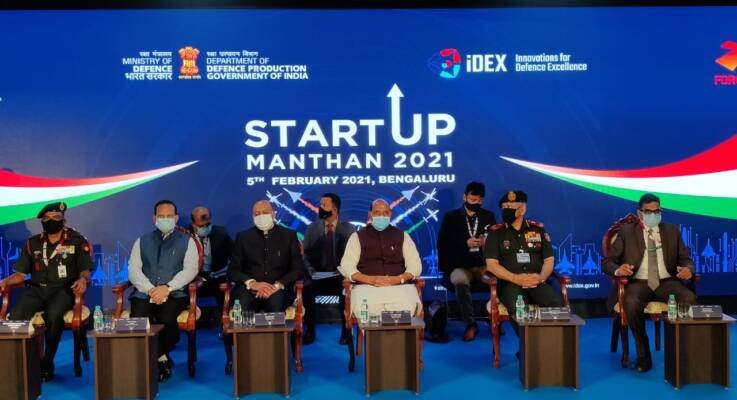
Speaking on the Conclave, Air Chief Marshal RKS Bhadauria highlighted the geo political tensions which have reinforced the importance of matured and balanced cooperation at the international level. The existing security frameworks are based on the principal of cooperation, collaboration and co-existence. Indian Air Force has built bridges of friendship through numerous bilateral and multilateral exercises with the large of nations who shares common values and interest in maintaining peace and stability. These joint exercises have helped us learn and grow together.”
Finding the solution for New Warfare Operations
Speaking at the Chiefs of Air Staff Conclave, Air Marshal R D Mathur said, “For any Air Force, the strategic and tactical paraphernalia are the two sides of the same air power coin.” The modern air parts can deliver tactical and strategical air power operations in the contemporary times. In the same time, there has been observed the considerable changes in our neighbour countries as well as regional and global scenario. Challenges have grown and future challenges have already started arriving, demanding the strategical air power solutions. Therefore, there is need of establishing the appropriability between the sensor and the shooter.”
Highlighting the importance of having joint and multi domain command and control in the air power, Air Marshal Mathur said, “There is a requirement to operate jointly and set up a comprehensive solution to many growing challenges in the warfare scenario and one such is threat from weaponised drones. The major transformation will be needed for any Air Force who wants to retain current relative advantage to the present situation in any other armed services.”
Air Power and Aerospace Engineering
In the recent years, the country is witnessing a paradigm shift in the geo political landscape and globally facing the unprecedented levels of uncertainties volatilities and inter-connected threats. The rising mistrust and geo political tensions are few causes of terrorisations, giving the platform for undesirable attacks. Nevertheless, Indian armed forces have gained a wealth of experiences and expertise over the years to tackle and combat the any situation arising out of zone. Speaking of aerospace power and IAF capabilities in combating the fresh alarming subject, the disruptive technologies have different story to speak. Defending is one part but dealing with disruptive techs is another fragmented topic. With the scenes where extensive vicissitudes are revolving in our neighbourhood countries, newer concerns are added challenges with regard to old issues. Though the role of our military power cannot be denied for past few years, yet security concerns are major thrust in the global and regional scenario.
The significant role of Aerospace has increased and now demanding the futuristic development. During Aero India 2021 seminars held the proactive role of air space engineering were widely discussed. On the occasion, DRDO Chairman Dr G Satheesh Reddy emphasised on the aeronautical research development and aerospace applications, flexibility of bringing the whole aeronautical under the one umbrella without comprising the security concerns.
The Aerospace & Defence sector in India has come a long way. Its private and public sector industries in this sector are at the forefront of developing state-of-the-art technologies. The recent order from the Indian Air Force of 83 LCA to HAL is a milestone in marching for developing indigenous defence manufacturing capabilities.
The Indian aerospace and defence industries present an attractive and significant opportunity for foreign companies across the supply chain to take their cooperation to newer levels. India is ready to supply various types of Missile systems, Light Combat Aircraft / Helicopters, Multi-Purpose Light Transport aircraft, Warship and Patrol Vessels, Artillery Gun systems, Tanks, Radars, Military Vehicles, Electronic Warfare Systems and other weapons systems to IOR countries.
Air Space Power and Limiting the Procurement of Aerospace Materials
In the traditional or contemporary era, Air space has been always playing a substantial role in the IOR region. Taking the cue from earlier experiences across the globe, we find that there is need to establish solid Airspace power to deal with the challenges. At the same time, it is worth mentioning that our Indian space organisations have done great job in strengthening the Air Power. “India’s growing strength and capabilities in aerospace and defence sector are now being realised by everyone,” said Defence Minister. Speaking in the inaugural event, the Defence Minister asserted that “India is vigilant and capable of handling any challenge.” On the other hand, while inking the deal of Tejas aircraft, Rajnath Singh said India is ready to supply weapons systems to countries in Indian Ocean Region.
Defence Research and Development Organisation exhibits India’s under-development fifth-generation fighter aircraft Advanced Medium Combat Aircraft at Aero India 2021. As per DRDO, the aircraft would come with stealth features and all capabilities of a multirole fighter plane.
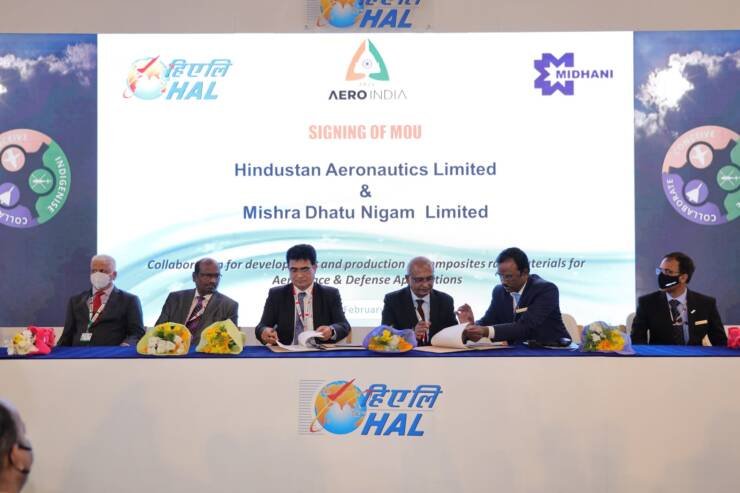
The usage of composites in the aerospace is going to exist and increase, particularly for fighter aircraft/ helicopter because of its inherent advantages over metallic raw materials. In addition, similar requirement exists for other aerospace and defence programmes, including those of Indian Space Research Organisation (ISRO), Defence Research Development Organisation (DRDO) and National Aerospace Laboratories (NAL).
On such a great note, signing of MoU for development and production of composite raw materials is a major step towards creating a holistic approach of strengthening Aerospace. This is the first time that such a MoU has been signed for composite raw materials. The MoU was signed by Chairman and Managing Director, HAL, R Madhavan and Chairman and Managing Director, MIDHANI Dr S K Jha in the presence of other senior officials on February 4, in the Aero India 2021 event.
R Madhavan said composites are one area where HAL will collaborate. Composites raw materials, mainly in the form of prepregs used in platforms like Light Combat Aircraft (LCA), Advanced Light Helicopter (ALH), Light Combat Helicopter (LCH) and Light Utility Helicopter (LUH) are currently imported.
The CMD of MIDHANI SK Jha said this is the major step forward in the area of composite materials. The HAL is not only taking care of frontline aircraft production but also raw materials. There is no equivalent proven Indian approved/ qualified supplier for various types of prepregs (carbon, aramid, glass types, etc) for the aircraft applications. This creates dependency on foreign Original Equipment Manufacturers (OEMs).
Aligned with “Atmanirbhar Bharat” initiative, efforts need to be made to develop and manufacture such prepregs in India through collaboration, he added.
Moving forward to Defence Start up Initiative
While addressing at Start-up Manthan organised on February 5, Defence Minister announced that 45 MSMEs participating in Aero India have received orders worth Rs 203 crore. The annual flagship event was organised on the final day of Aero India 2021.
He said the iDEX initiative is a decisive step towards achieving self-reliance and is one of the most effective and well-executed defence Start-up ecosystems in the true spirit of Atmanirbhar Bharat.
Speaking on the aerospace sector, Rajnath Singh added that 300 plus start-ups are currently engaged and iDEX 10 start-ups have developed the products worth Rs 100 crore which have been displayed in Aero India 2021. Further he highlighted iDEX4Fauji as an initiative providing opportunities to innovate to the Indian Armed Forces. He further said that iDEX4Fauji opens up a new window allowing Indian soldiers and service personnel to be recognised and rewarded as innovators. He mentioned the Innovations done in the field of Robotics in Maritime applications by Lt. Deepak Suman Kumar and wall penetrating Radar by Major Anoop Mishra are fine examples.
Rolling for Self-Reliant India – the major thrust in this mega event
Our efforts are to synergise the resources and efforts in the Indian Ocean, including, defence Industry industrial cooperation among participating countries,” Rajnath Singh said.
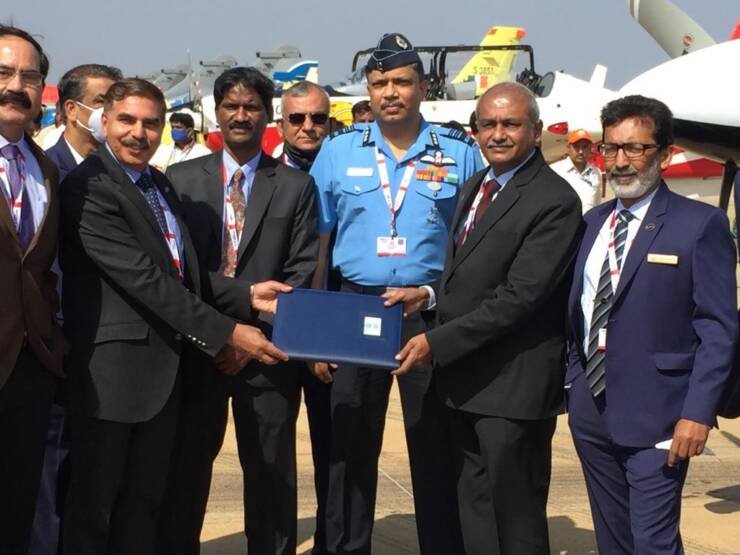
Indian Air Force operates a variety of aircraft fleets of foreign origin ranging from legacy MiG-21 Bison to the state-of-the-art Rafale aircraft. For increased self-reliance and to meet sustenance requirements in product support of IAF aircraft and systems, indigenisation of aircraft as well as systems spares and setting up of indigenous Repair and Overhaul (ROH) facilities for aggregates are key focus areas of IAF.
There is immense scope for indigenisation in the IAF for a wide variety of spares and equipment ranging from aircraft general purpose spares, such as nuts, bolts, cables, gaskets, springs, etc. to complex high technology spares, such as avionics equipment, aeroengine accessories, etc. Indigenisation of spares for maintenance of aircraft and systems is undertaken through Base Repair Depots (BRDs) of IAF located in various parts of the country and No. 1 Central Indigenisation and Manufacturing Depot (CIMD), Nashik.
As part of focus on Self-Reliance and Atmanirbhar Bharat mission, IAF is giving impetus to fast tracking of indigenisation as well as enlarging the scope of involvement of Indian aerospace and defence industry especially, MSMEs. Towards this, IAF has already identified indigenisation requirements of approximately 4,000 lines of spares. Critical requirements for indigenisation include aviation grade filters (fuel, hydraulic & pneumatic), aeroengine bearings, hydraulic and pneumatic hoses, multifunction displays, aviation grade circuit breakers, lamp filaments, spark plugs, etc. to name a few. Enormous opportunities are available for the aerospace and defence industry partners in India including MSMEs to join hands with IAF in this vigorous indigenisation drive.
In addition to manufacture of spares and aggregates, another area of focus of IAF is to engage with the industry to set up repair and overhaul (ROH) facilities within India for high value rotatable/repairable. In achieving this objective, IAF aims to accrue huge savings to the financial exchequer, besides developing and encouraging in-house MRO facilities, thereby leading to reduced timeframes for repair and enhanced operational availability of assets. In addition, a list of over 200 lines of high value ex-import spares (unit cost > Rs 10 lakh) has been hosted in the Ministry of Defence website srijandefence.gov.in.
So far Indian Air Force has laid down the blueprint for developing its own hybrid technologies and manufacture indigenous aircrafts. The IAF has come a long way and has demonstrated its professionalism and the world has acknowledged it.
In the valedictory ceremony held on February 5, HAL handed over three Advanced Light Helicopters (ALH) Mk III to Indian Navy and two ALHs to Indian Coast Guard as part of its 16 ALHs contract during the ongoing Aero India 2021 at Air Force Station Yelahanka, Bengaluru. The helicopters were handed over by HAL CMD R Madhavan to Chief of Naval Staff (CNS) Admiral Karambir Singh and Director General Coast Guard K Natarajan in the presence of Defence Minister Rajnath Singh.
India’s Defence & Aerospace vision rests on three pillars – R&D, Public-Private Defence Production and Exports
A total of 201 MoUs, product launched and technology transfers were concluded at the Bandhan ceremony held on the last day of Aero India 2021 at Yelahanka, Bengaluru on February 5. These included the formal handing over of the Advanced Light Helicopters MK-III to the Indian Navy and Indian Coast Guard (ICG), commencement of Performance based logistics of ICG fleet, initial operational clearance of Army version of Light Utility Helicopter etc.
In his address, the Defence Minister said, “Bandhan exemplifies the spirit of public-private partnership in defence and aerospace sectors and have forged strategic ties that are poised to transform defence and aerospace manufacturing. He said 128 MoUs, 19 ToTs, four Handing Overs, 18 Product Launches and 32 major announcements were made at Aero India this year. He said Prime Minister Narendra Modi’s clarion call for Atmanirbhar Bharat ignited the country’s spirit of innovation and collaboration.”
Emphasising on the foundation of Self-Reliant India, the Defence Minister asserted India rests on three pillars – Research and Development, Public and Private Defence Production and Defence Exports. Referring to the field of research and development, he said there was an attempt to broaden the research base of the nation by supporting and encouraging the private sector. In this context, he mentioned that some patents of DRDO have been shared with the private sector to assist in defence production ventures.
Rajnath Singh mentioned initiatives to encourage and facilitate private sector R&D initiatives such as iDEX and Defence India Start-up Challenge (DISC). He recalled innovations such as the combat drone display, a part of the swarm technology initiative, exhibited during the Army Day function in New Delhi on January 15.
The Defence Minister reiterated India’s intention to bring down defence imports by at least US$2 billion by 2022 to encourage local defence manufacturing. He informed that 138 proposals worth over US$37 billion for domestic manufacturing were approved between 2016 and 2019.
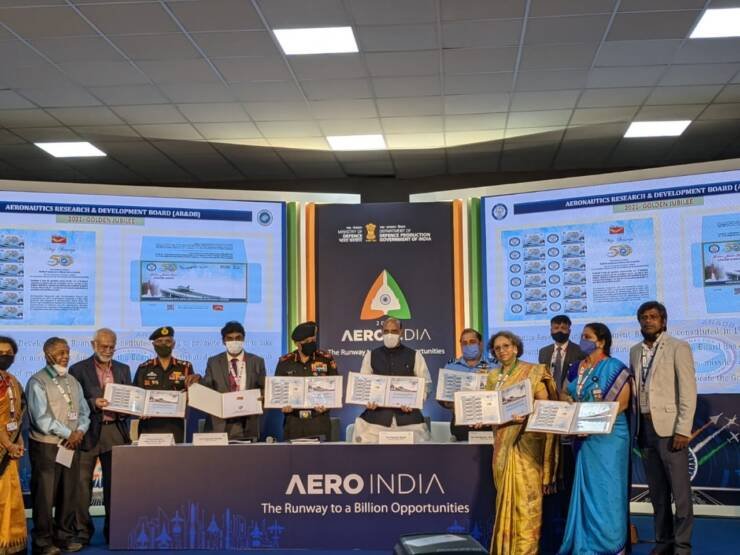
Highlighting the importance of the requisite eco-system for the growth of the defence industry, Rajnath Singh said Rs 6,800 crore investments were pledged by both public and private industries in the defence corridors of Uttar Pradesh and Tamil Nadu.
The Defence Minister also spoke of the need for a robust domestic manufacturing base for defence export potential of the country. He reiterated the target of increasing the country’s defence base from US$11 billion to US$25 billion by 2025 including an export component of US$5 billion. Defence exports grew from Rs 2000 crores to Rs 9000 crores from 2015-2020 with a vast majority spearheaded by the private sector. With reference to the Indian aerospace industry he said that the aero components sector is set to grow from Rs. 30,000 crores today to Rs. 60,000 crores by 2024.
He enumerated the cost competitiveness of India’s manpower resources, availability of abundant, specialist capabilities and geographical advantages as reasons for its emergence as a global and regional Maintenance, Repair and Overhaul (MRO) hub. Hailing the agreements concluded at Aero India 2021, the Defence Minister said they would give impetus to ‘Make in India’ and ‘Atmanirbhar Bharat’ and assured the gathering his Ministry would do everything possible to ensure the agreements are implemented.
In Conclusion
Overall the Aero India 2021 pave the way for indigenisation of defence products yet major emphasis is given on the indigenous design developed by R&D done by DRDO. For the past few years we have seen tremendous efforts from DRDO in shaping and bringing the new technologies for defence sector. Collaborating with Indian Defence Industry under Make in India campaign for creation of own designed weapon, we have seen a rise in this arena. However, the irony of the age is India is still importing two billion defence raw materials. The current situation demands for extensive manufacturing of strategic materials in aerospace from stealth aircraft to sensor making for drones, and other raw materials for manufacturing of aircraft.
In the last few years, the three wings of our Armed Forces have worked significantly and in collaboration towards the mission of Atmanirbhar Bharat from making of battle tanks to submarines. However, a lot more is yet to be done to achieve and fulfil the demands of Indian Armed Forces and grow defence industries to meet the demands of globe. A strong and professional Armed Force can contribute to national security and to peace and stability, not only within the country but also within the region.
It is a considered opinion that the Indian Armed Force with its current capability and plans has the potential to make a very significant impact on meeting demand and moving successfully towards resolving the problem statements arising of neighbouring countries.
-The writer is a Meghalaya-based defence journalist








